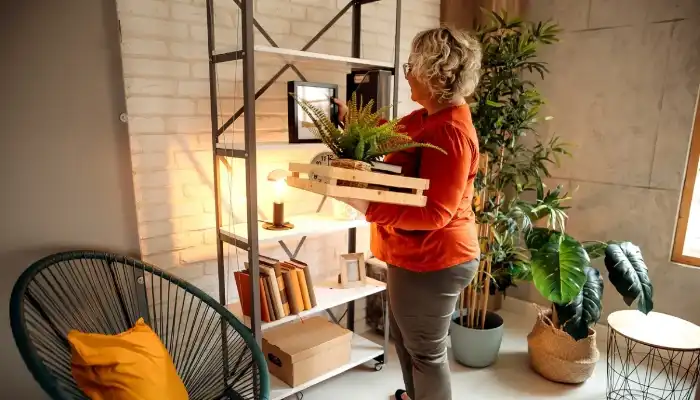Do you ever feel overwhelmed by the sheer volume of stuff in your home? Do overflowing closets and crowded countertops leave you feeling stressed and unproductive? If so, you’re not alone. Clutter – an excessive accumulation of possessions – is a common problem plaguing homes and minds alike. But the good news is, decluttering doesn’t have to be a daunting task. With a strategic approach and a commitment to organization, you can transform your cluttered space into a haven of peace and productivity.

What is Clutter, and Why Does it Matter?
Clutter refers to any physical object that no longer serves a purpose, brings you joy, or contributes positively to your life. It can include anything from outdated clothes and unused electronics to sentimental trinkets and overflowing piles of papers. While seemingly harmless at first, clutter can have a significant impact on your well-being:
- Increased Stress and Anxiety: Living in a cluttered environment can be overwhelming and visually stimulating, leading to feelings of stress and anxiety. The constant visual reminder of untidiness can make it difficult to relax and unwind.
- Reduced Productivity and Focus: Clutter creates mental clutter. Surrounded by excess belongings, it becomes harder to focus on tasks and maintain concentration. The constant visual distraction can hinder your ability to be productive.
- Diminished Sense of Well-being: A cluttered environment can negatively impact your mood and overall well-being. Feeling overwhelmed by your possessions can lead to feelings of frustration, helplessness, and even shame.
Understanding the Roots of Clutter: Why We Accumulate Stuff
Before tackling the clutter itself, it’s important to understand the reasons behind it. Here are some common culprits:
- Emotional Attachments: We often hold onto possessions for sentimental reasons, even if they no longer serve a practical purpose. Letting go of these items can be challenging, but it’s an essential step in the decluttering process.
- Lack of Organization Systems: Without proper storage solutions and organizational systems, it’s easy for belongings to accumulate and become disorganized. This makes it difficult to keep track of what you own and can lead to feelings of overwhelm.
- Overabundance of Belongings: We often fall prey to consumer culture, acquiring new possessions without critically evaluating their necessity. This can lead to an overabundance of belongings that contribute to clutter.
Decluttering Your Way to a Calmer You: Practical Strategies for Success
Now that you understand the impact of clutter and its potential causes, let’s delve into practical strategies to declutter your home and reclaim your space:
A. Start Small and Conquer:
Trying to declutter your entire home in one day is a recipe for discouragement. Instead:
- Focus on one area at a time: Choose a manageable space, like a drawer, shelf, or closet, and tackle it intensively before moving on. This approach provides a sense of accomplishment and keeps you motivated.
- Set achievable goals: Don’t aim to declutter your entire house in a weekend. Set realistic goals, like decluttering one area per week or getting rid of 10 items per day. Small, achievable goals are easier to maintain and celebrate.
B. Categorize and Conquer:
Once you’ve identified your decluttering zone, it’s time to sort through your belongings. Here’s a helpful approach:
- The Sorting Trio: Divide your belongings into three categories: keep, donate/sell, and discard. Be honest with yourself about what you truly use, love, and need.
- Sorting Strategies: There are various sorting methods to aid your decluttering journey. The KonMari method, for example, encourages holding each item and asking if it “sparks joy.” Choose a strategy that resonates with you and helps you make mindful decisions.
Table 1: Popular Decluttering Sorting Methods
| Method | Description | Benefits |
|---|---|---|
| The KonMari Method | Focuses on keeping items that “spark joy.” | Encourages an emotional connection with possessions. |
| One-Year Rule | Discard items you haven’t used in the past year. | Helps identify unused and unnecessary belongings. |
| Category-Based Decluttering | Focus on decluttering one category (e.g., clothes, books) at a time. | Provides a structured approach, especially for large collections. |
C. Create Storage Solutions:
Once you’ve sorted through your belongings, it’s crucial to have designated storage solutions to prevent clutter from creeping back in. Here are some tips:
Here are some ways to utilize storage bins, shelves, and organizers to effectively manage your belongings after decluttering:
- Invest in storage bins, shelves, and organizers that fit your space and needs. Measure your shelves and cabinets before purchasing storage solutions to ensure proper fit. Choose clear bins for easy visibility of contents or opt for opaque bins for a more streamlined look.
- Maximize vertical space. Utilize wall-mounted shelves, over-the-door organizers, and stackable bins to take advantage of vertical space and minimize floor clutter.
- Label everything. Clearly label bins, shelves, and drawers with categories or contents. This makes it easier to find what you need and reduces the need to rummage through everything.
- Categorize by use and frequency. Store frequently used items within easy reach, while less frequently used items can be placed on higher shelves or in labeled bins. Group similar items together for better organization (e.g., dedicate a shelf for board games or a bin for cleaning supplies).
D. Establish Decluttering Routines:
Decluttering shouldn’t be a one-time event; it’s an ongoing process. Here’s how to integrate decluttering into your routine:
- Daily tidying habits: Develop the habit of putting things away after use. This prevents clutter from accumulating and makes maintaining order easier. Spend a few minutes at the end of each day tidying up common areas like the kitchen or living room.
- Weekly decluttering sessions: Schedule dedicated decluttering sessions, even if it’s just for 15 minutes. Focus on a specific area each week or tackle a particular category of belongings. This consistent approach prevents clutter from overwhelming you again.
Letting Go: Embracing Minimalism with Mindfulness
Decluttering isn’t just about throwing things away; it’s about making mindful choices about what to keep and what to let go of. Here are some strategies to ease the process:
- Usefulness vs. Sentimentality: Evaluate each item. Does it serve a practical purpose in your daily life? If not, can you justify keeping it solely for sentimental reasons? Consider photographing sentimental items to preserve the memory without the physical clutter.
- The Pareto Principle (80/20 Rule): This principle suggests that 80% of the consequences come from 20% of the causes. Applied to decluttering, it means that 80% of the clutter you experience comes from 20% of your belongings. Identify those few categories (clothes you never wear, unused kitchen gadgets) and focus on decluttering them first.
- Visualize the Benefits: Imagine yourself in a clutter-free space. Picture the calmness, the ease of finding things, and the increased sense of peace. Hold onto this visualization as motivation when letting go of possessions becomes challenging.
Maintaining a Clutter-Free Lifestyle
Decluttering is an ongoing process, but with these habits, you can keep clutter at bay:
- Practice mindful consumption: Before making a purchase, ask yourself if you truly need the item. Consider its purpose, quality, and potential longevity. Could you borrow it instead, or opt for a multi-functional option?
- The “One-In, One-Out” Rule: For every new item you bring into your home, consider donating or discarding an existing one. This helps maintain a balance and prevents clutter from accumulating.
- Regular Reassessment: Schedule regular decluttering sessions, perhaps quarterly or bi-annually, to revisit your belongings. This allows you to identify items that are no longer needed or used and prevents clutter from creeping back in.
Conquering Common Decluttering Challenges
Decluttering isn’t always easy. Here’s how to tackle common obstacles:
- Procrastination: Break down the decluttering process into smaller, more manageable tasks. Set a timer for 15 or 30 minutes and focus on decluttering one area during that time. You might be surprised at what you can accomplish in a short burst!
- Sentimental Items: Take photos or videos of sentimental items to preserve the memories without keeping the physical object. Consider creating a memory box for cherished keepsakes.
- Family Clutter: Lead by example and create designated storage solutions for shared spaces. Communicate openly with family members about the benefits of decluttering and set clear boundaries around their belongings in common areas.
Decluttering for a Sustainable Future
Decluttering isn’t just about creating a tidy home; it can also be a sustainable practice:
- Donate or Recycle: Give unwanted items a second life by donating them to charity organizations or thrift stores. Many communities also offer recycling programs for e-waste and other materials.
- Repurpose or Upcycle: Get creative! Can you transform old furniture, clothing, or other items into something new and useful? Upcycling reduces waste and allows you to personalize your belongings.
- Avoid Unnecessary Purchases: Resist impulse purchases and focus on buying quality items that will last. Consider borrowing or renting items you need infrequently.
The Psychological Impact of Decluttering
Studies have shown a clear link between clutter and mental well-being:
- Reduced Stress and Anxiety: Living in a cluttered environment can be overwhelming and visually stimulating, leading to increased stress and anxiety. Decluttering creates a calmer and more organized space, promoting relaxation and mental clarity.
- Improved Cognitive Function: Clutter can overload your senses and make it difficult to focus. A decluttered space provides a clearer visual landscape, leading to improved cognitive function, decision-making, and productivity.
- A Sanctuary for Relaxation and Creativity: A clutter-free home becomes a haven for relaxation and creativity. Without the visual distraction of clutter, you can unwind, de-stress, and tap into your creative potential.
Conclusion
Decluttering your home isn’t just about creating a tidy space; it’s about creating a sanctuary for your well-being. By letting go of excess possessions, you can cultivate a calmer, more organized environment that fosters relaxation, creativity, and a sense of peace. Remember, decluttering is a journey, not a destination. Start small, be patient with yourself, and celebrate your progress.
As you declutter your home, you’ll be decluttering your mind and paving the way for a more mindful and fulfilling life. So, take a deep breath, embrace the process, and reclaim your haven of peace, one decluttered space at a time.


